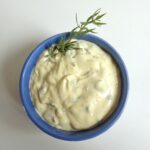 One of the simplest weeknight dinners I know is baked fish, in this case fillets of haddock with homemade tartar sauce, French style. The fish is dusted with salt, pepper and a little cumin — no flour is involved — and drizzled with olive oil before being roasted in a hot oven for 10-15 minutes, depending on the thickness of the fillets. While the fish is cooking you can whip up the tartar sauce, and presto. Dinner is ready in less than half an hour.
One of the simplest weeknight dinners I know is baked fish, in this case fillets of haddock with homemade tartar sauce, French style. The fish is dusted with salt, pepper and a little cumin — no flour is involved — and drizzled with olive oil before being roasted in a hot oven for 10-15 minutes, depending on the thickness of the fillets. While the fish is cooking you can whip up the tartar sauce, and presto. Dinner is ready in less than half an hour.
Eglefin au four sauce tartare / Baked haddock with French tartar sauce
Sauce tartare / French tartar sauce
Before returning to the subject of the sauce, I’d like to say a few words on the subject of the fish. First, it doesn’t have to be haddock. The recipe works well with all types of fish fillets. Second, fresh fish will produce superior results, but frozen fish may be used as well (so long as the fillets are fully defrosted before you begin). Third, and here is where it gets interesting from a linguistic point of view, what do the French mean by haddock?
 The answer, mes amis, is that they mean ‘smoked haddock’, which is sold here in bright yellow-orange skin-on fillets. But not to panic. This recipe calls not for haddock (pronounced ah-DUCK), but rather for églefin, or ‘fresh haddock’.
The answer, mes amis, is that they mean ‘smoked haddock’, which is sold here in bright yellow-orange skin-on fillets. But not to panic. This recipe calls not for haddock (pronounced ah-DUCK), but rather for églefin, or ‘fresh haddock’.
 Oddly, the word églefin derives from a Dutch word, schelvisch, which looks more like shellfish to me. But languages evolve in mysterious ways, and somehow over the centuries the word changed to something that sounds far more French — égle evoking aigle, or ‘eagle’, and fin meaning ‘fine’ or ‘thin’…
Oddly, the word églefin derives from a Dutch word, schelvisch, which looks more like shellfish to me. But languages evolve in mysterious ways, and somehow over the centuries the word changed to something that sounds far more French — égle evoking aigle, or ‘eagle’, and fin meaning ‘fine’ or ‘thin’…
But this does not answer the question of: why two words for the same fish? Well, one only has to think about ‘kippers’ (smoked herring) and ‘herring’ (other forms of herring) to understand. This fishy linguistic duplicity can be tricky for people new to France. I remember that when I moved to Paris in the ’70s it took me a long time to figure out that cabillaud (fresh cod) and morue (dried salt cod) were indeed the same fish.
 Ok, now on to the sauce. How is French sauce tartare different from the tartar sauce served, say, in the States or in England? Well, for one thing it isn’t sweet. For another it uses capers and can dispense with pickles or pickle relish altogether. This produces a more sophisticated flavor, in my view.
Ok, now on to the sauce. How is French sauce tartare different from the tartar sauce served, say, in the States or in England? Well, for one thing it isn’t sweet. For another it uses capers and can dispense with pickles or pickle relish altogether. This produces a more sophisticated flavor, in my view.
French sauce tartare combines the capers with mayonnaise, lemon juice and chopped fresh herbs. You don’t need to make the mayo. Store-bought is just fine — but check the sugar content (no sugar = more authentic). The French sometimes also include chopped cornichons, the tiny vinegar-cured cucumbers that pass for pickles over here. But as they are hard to find elsewhere, I have omitted them from today’s recipe. And to be honest, I prefer my sauce tartare without the cornichons.
French tartar sauce marries beautifully with fish and shellfish, and may also be used alongside chicken, veggies and cold meats. It takes no more than 5 minutes to prepare.
Happy cooking.





Thank you Meg for this recipe. Very simple, very good. I made the sauce tartare for the first time and with mayonnaise maison (of course!) it was delicious.
Fabienne
Fabienne, bravo! And of course it’s best with homemade mayo!!